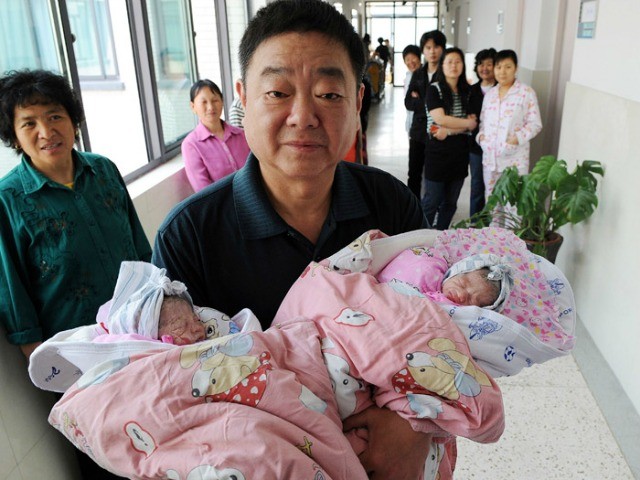China has announced that after 34 years of restricting population growth through its one-child policy, the nation will now allow families to have two children if one of the parents is an only child.
The policy “initially produced a population pyramid optimal to economic growth – that is, where the largest segments of the population were neither young nor old, but in the middle (i.e. working age).” Although there were a number of exemptions to the one-child policy, Chinese population growth was cut by 200 million as the birthrate dropped from 4.77 children per female in the 1970s to just 1.58 in 2012. However, the strategy also resulted in massive female infanticide, and now a ticking time bomb from millions of unwed young men threatens to ignite revolutionary violence.
According to Steven Mosher, president of the Population Research Institute in Washington, D.C., “Twenty-five million men in China currently can’t find brides because there is a shortage of women.” For the young in China, the ratio is 117 men for every 100 women. Conservative estimates indicate the number of young adult males unable to find a bride will rise to about 30 million by 2020. One of the top television shows is in China is a brutally humiliating weekly matchmaking show, If You Are The One, where eligible females turn down advances from lots of desperate eligible men.
Unfortunately, China has a bad history when it comes to lack of eligible wives. Two horrendous floods and a subsequent famine devastated northeastern China in the mid-19th century. According to political scientists Valerie Hudson and Andrea den Boer, female infanticide was so rampant during the famine that about 25% of young men in the region were “bare branches” as the Chinese call it–unlikely ever to bear fruit in the form of children. With no hope of families, the bare branches rebelled and formed into huge bands of young male outlaws known as “nien” that wreaked havoc on the Chinese economy. The Nien Rebellion contributed to civil war and the end of the Qing Dynasty.
In addition to the risk of physical violence, worker shortages are also beginning to be a China problem. Because the working age population of China started falling for the first time in 2012; the local joke is, “China will be the first country in the world to get old before it gets rich.” Currently 8.5%–114.8 million of China’s 1.3 billion people–are over 65; that number will almost triple to 23.9%–300 million, by 2050.
However, more births will mean more demand for China’s scarce water supply. The average Chinese only consume a per capita 22 gallons of water a day, compared to 150 gallons in the U.S. Agriculture remains the primary user, accounting for 60-70% of China’s annual freshwater resources. And China’s urbanization and rising middle class has fostered a greater demand for municipal drinking and wastewater. This has intensified the precarious water supply-demand imbalances in many agricultural regions and driven food prices up. If Beijing carries out its plan to shift another 250 million farmers to cities over the next seven years, water needs will grow significantly.
Water also plays an essential role in every step of the energy supply chain–from mining, drilling, fracturing and refining to power generation and chemicals production. According to Stratfor Global Intelligence reports, China’s total domestic energy (mostly coal) output doubled, driving the sector’s percentage share of total national water use to 13%. The problem is especially acute in the country’s water-scarce northwest regions, where most of the domestic coal and natural gas production are located.
China is currently facing very similar demographic challenges as those experienced by Japan two decades ago. “Like China now, the Japanese economy was toast of the world in the mid-to-late 1980s but hit the wall from 1991 when its joint property and stock market bubbles collapsed and its working population began to shrink.” While Japan was rich by the time its demographic bomb exploded, China is still poor.
Relaxing the one-child policy may ultimately assist in rebalancing the Chinese economy towards domestic consumption, since younger people tend to spend a higher share of their income than older people. But benefits from the change in the one-child policy will take decades to have much impact on China’s demographics. During the interim, the millions of “bare branches” are going to grow in number–and also grow in anger.

COMMENTS
Please let us know if you're having issues with commenting.